Sign up for CNN’s Wonder Theory science newsletter. Explore the universe with news on fascinating discoveries, scientific advancements and more.
SpaceX’s Starship, the most powerful launch vehicle ever built launched Thursday and achieved key objectives laid out for its fourth test flight that demonstrated the vehicle’s reusability. The highly anticipated event was the company’s second uncrewed test of 2024.
Launch occurred from the private Starbase facility in Boca Chica, Texas, at 7:50 a.m. CT (8:50 a.m. ET), and the company streamed live coverage on X, formerly known as Twitter, drawing millions of viewers.
The Starship launch system includes the upper Starship spacecraft and a rocket booster known as the Super Heavy. Of the rocket’s 33 engines, 32 lit during launch, according to the SpaceX broadcast.
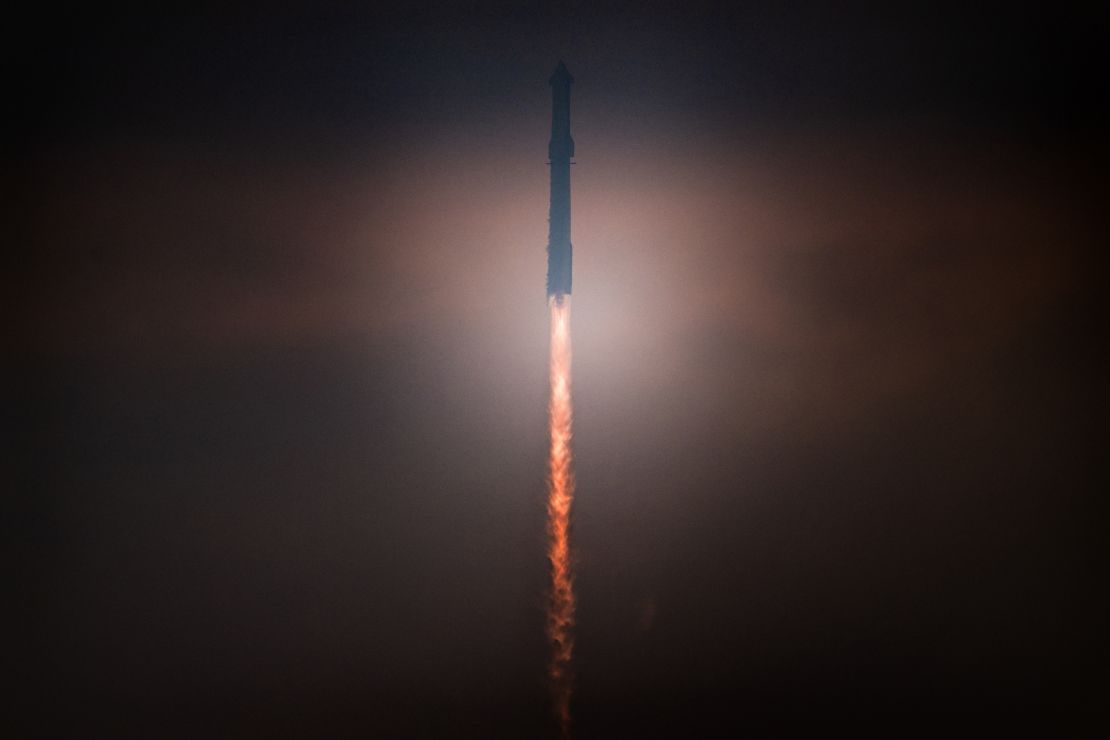
The vehicle soared through multiple milestones during Thursday’s test flight, including the survival of the Starship capsule upon reentry during peak heating in Earth’s atmosphere and splashdown of both the capsule and booster.
After separating from the spacecraft, the Super Heavy booster for the first time successfully executed a landing burn and had a soft splashdown in the Gulf of Mexico about eight minutes after launch.
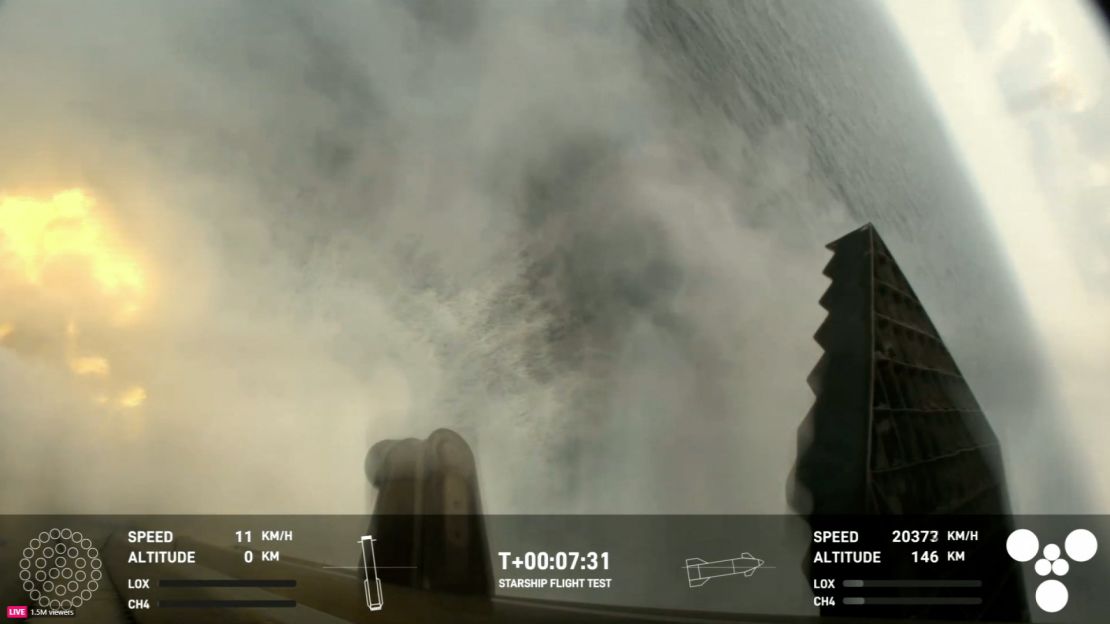
Meanwhile, the Starship capsule successfully achieved orbital insertion. About 50 minutes after launch, the spacecraft began its controlled reentry journey, and an incredibly colorful buildup of plasma could be seen around the vehicle as its heat shield faced the extreme temperatures of Earth’s atmosphere.
The company’s Starlink satellites helped facilitate a livestream that was continuously available during reentry. A flap near the camera view on Starship appeared to scorch during reentry and particulate matter blocked some of the view of the camera.
But in the end, there was enough of a view to see Starship achieve its expected landing burn into the Indian Ocean.
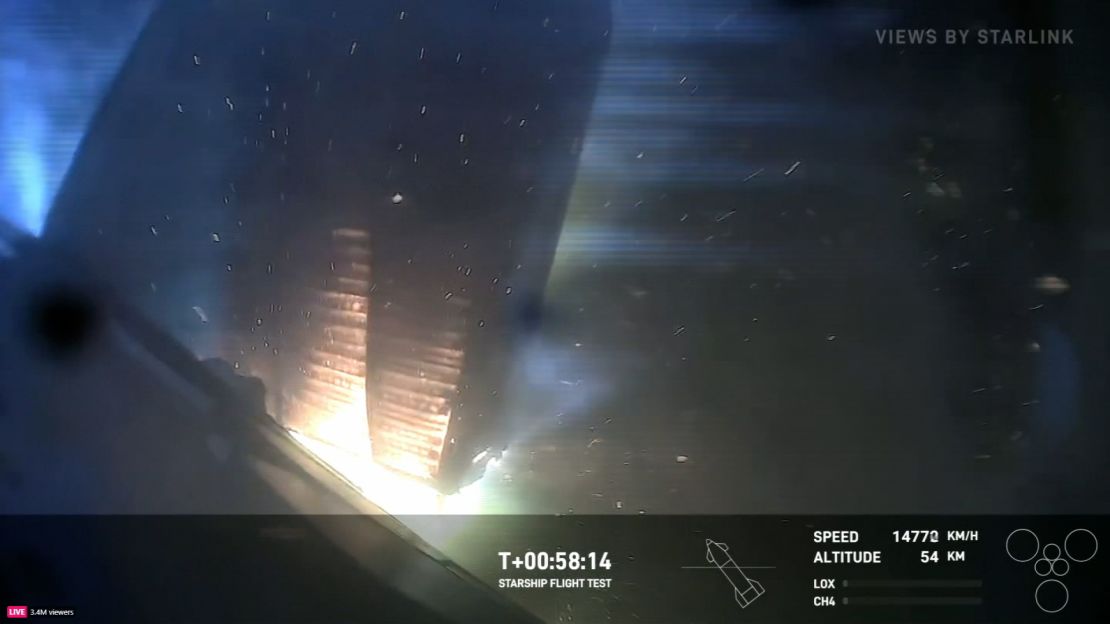
“Despite loss of many tiles and a damaged flap, Starship made it all the way to a soft landing in the ocean! Congratulations @SpaceX team on an epic achievement!!” posted SpaceX founder and CEO Elon Musk on X.
The Starship spacecraft is coated in about 18,000 lightweight, ceramic hexagonal tiles, which are designed to protect the vehicle during reentry.
NASA administrator Bill Nelson also took to X to share a post celebrating the flight.
“Congratulations @SpaceX on Starship’s successful test flight this morning! We are another step closer to returning humanity to the Moon through #Artemis—then looking onward to Mars,” Nelson posted.
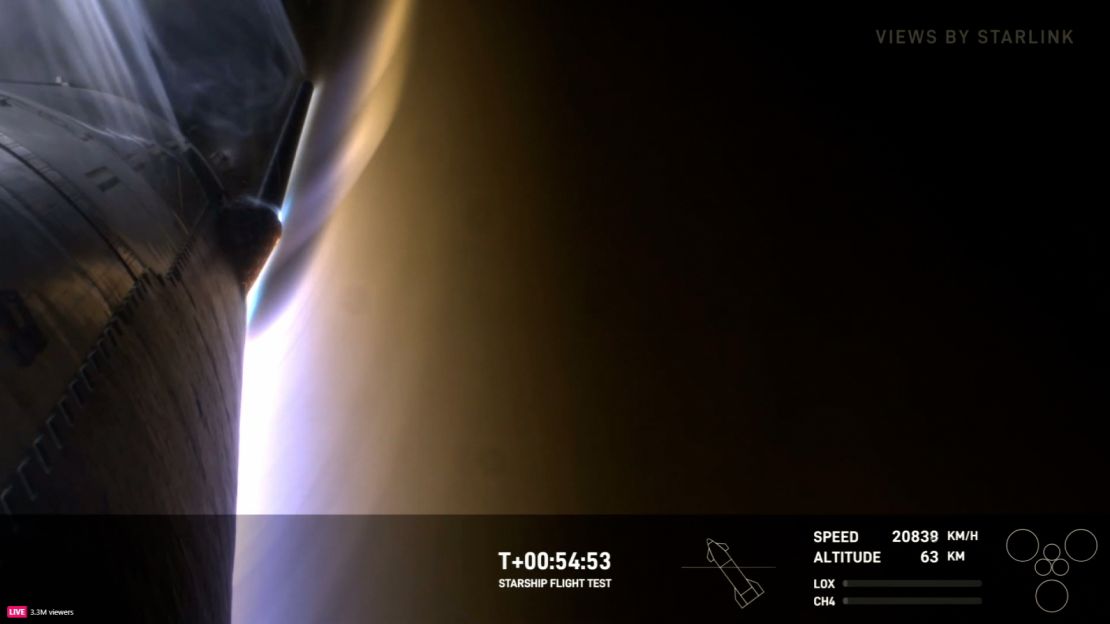
New flight, new goals
The launch was initially expected to occur at 7:20 a.m. CT (8:20 a.m. ET), but SpaceX’s red team was sent in to fix a ground-side issue, which caused the delay, according to the company’s livestream.
The flight test comes two days after the Federal Aviation Administration, which licenses commercial rocket launches, gave SpaceX its approval. And the test is occurring one day after SpaceX’s competitor under NASA’s Commercial Crew Program, Boeing, successfully launched the first crewed mission of Starliner, which is carrying two veteran NASA astronauts to the International Space Station.
Each of Starship’s test flights have different objectives that build on lessons learned and milestones achieved during the previous flight.
The Starship team made software and hardware upgrades to the launch system to incorporate lessons learned from the third flight.
“The fourth flight of Starship will aim to bring us closer to the rapidly reusable future on the horizon,” according to SpaceX. “We’re continuing to rapidly develop Starship, putting flight hardware in a flight environment to learn as quickly as possible as we build a fully reusable transportation system designed to carry crew and cargo to Earth orbit, the Moon, Mars and beyond.”
Three wild test flights
The first two attempts to get Starship to orbital speeds in 2023 ended in explosions, with the spacecraft and booster erupting into flames before reaching their intended landing sites.
SpaceX is known to embrace fiery mishaps in the early stages of spacecraft development, saying these failures help the company rapidly implement design changes that lead to better results.
SpaceX has said its approach to rocket development is geared toward speed. The company makes use of an engineering method called “rapid spiral development.” This process essentially boils down to a desire to build prototypes quickly and willingly blow them up to learn how to construct a better one — faster than if the company solely relied on ground tests and simulations.
After the explosive first and second Starship test flights, the company immediately sought to frame these mishaps as successes.
The nearly hour-long third test flight, conducted in March, achieved several milestones before breaking apart after reentry, rather than splashing down in the Indian Ocean.
First, Starship reached speeds close to what would be required to put the vehicle in orbit. Typically, such a feat requires speeds topping 17,500 miles per hour (28,000 kilometers per hour). Starship reached its orbital speeds goal and did not aim to enter orbit on the third flight.
The Starship’s payload door — a hatch that must open for the spacecraft to deploy satellites into space after reaching orbit — swung open before resealing in a crucial test of that mechanism.
SpaceX also carried out a “propellant transfer demonstration,” or moving some of the propellant on board the Starship vehicle from one tank to another. SpaceX engineers designed the demo to test how Starship will be refueled on future missions while it’s in orbit.
But after a bright halo of red plasma, created by extreme heat and pressure as Starship reentered Earth’s atmosphere, glowed around the vehicle, the team lost communication with the spacecraft.
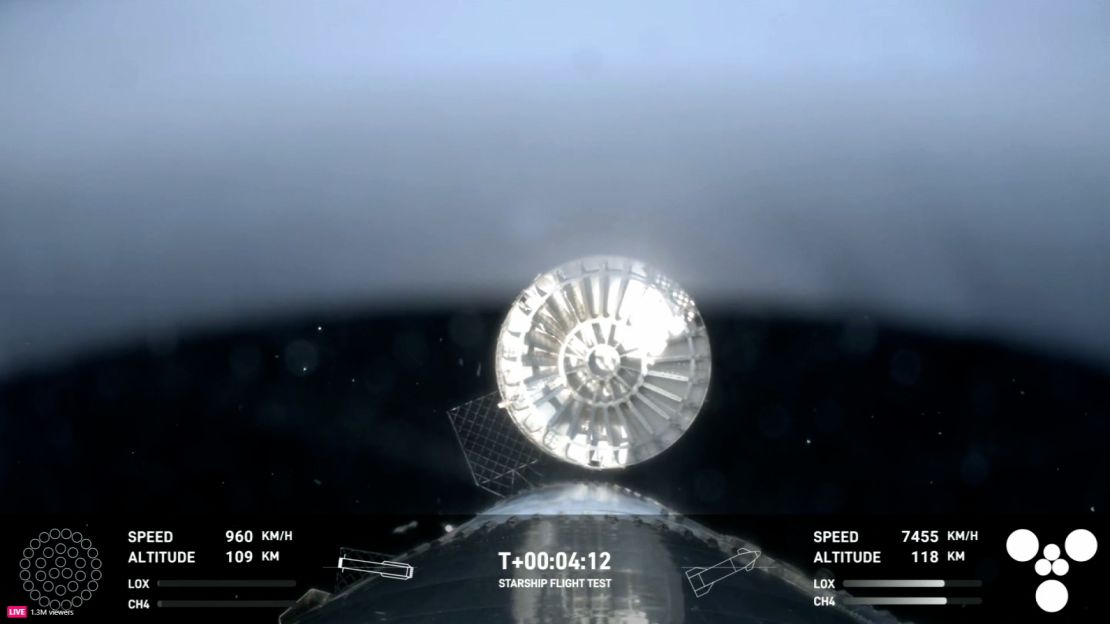
However, SpaceX never intended to recover Starship after this flight test.
The Super Heavy booster was also expected to make an autonomous, controlled landing in the ocean, but the booster was lost after all its engines failed to light.
But both the Starship spacecraft and booster made it farther into flight than the two previous tests in 2023.
For Thursday’s flight, SpaceX implemented upgrades and hardware and software changes to help the booster engines light, and additional thrusters were added to Starship to prevent it from experiencing any unplanned rolling, which also occurred during the third flight.
Starship’s gargantuan goals
Much is riding on Starship’s eventual success. SpaceX CEO Elon Musk has repeatedly characterized the rocket as central to the company’s founding mission: putting humans on Mars for the first time.
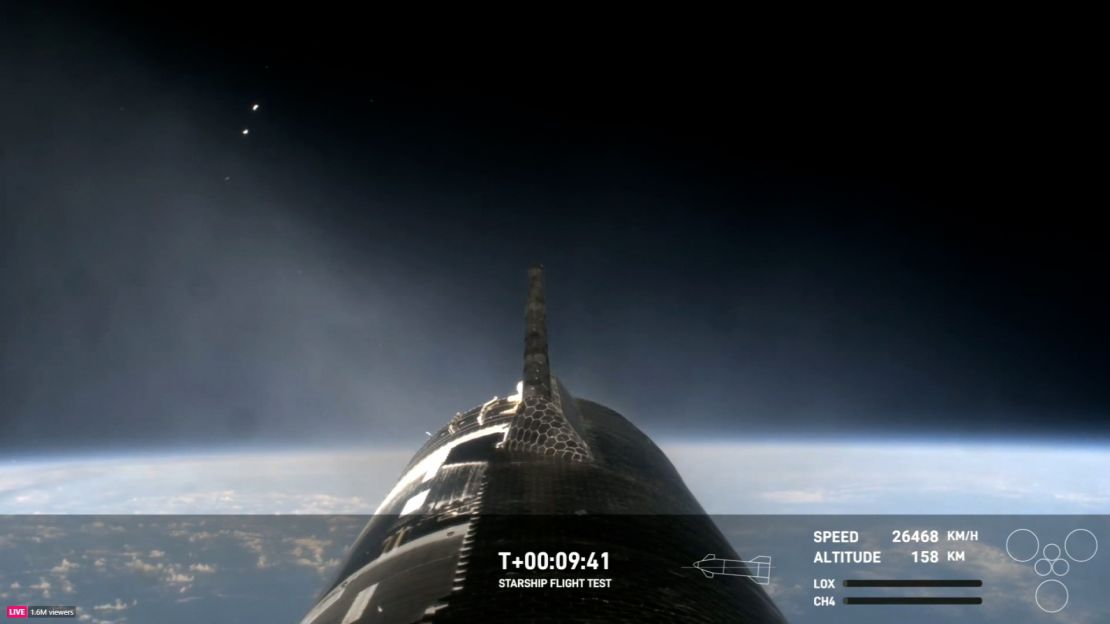
NASA has selected the Starship spacecraft for a key role in its Artemis program to return humans to the moon for the first time in more than five decades. Under the federal space agency’s current road map, Starship would complete the final leg of a crewed mission to the moon, taking the astronauts from a spacecraft in lunar orbit and ferrying them to the surface. The United States is in a race with China, vying to become first to develop a permanent lunar outpost and set the precedent for deep-space settlements.
Milestones such as the propellant transfer from the third flight test objectives for the future. Topping off the spacecraft’s fuel will be critical for Starship’s high-profile missions down the road.
When Starship makes a journey to the moon under Artemis — it will have to sit in orbit close to Earth as SpaceX launches separate support vehicles that will transport fuel to the spacecraft. To get to the moon, SpaceX may have to make more than a dozen refueling trips.
The first astronaut landing under the Artemis program is slated to occur as soon as September 2026.





















